
ready for the first trip of the day beside the Aberystwyth platform.
Vale of Rheidol Railway
Aberystwyth Wales United Kingdom
N52.414255 E4.082008
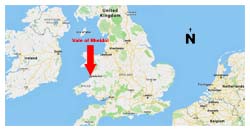
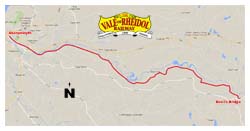
 Riding the Vale of Rheidol Railway today there is no visible evidence of it's purpose from the carriage, unlike the Ffestiniog Railway, where its immediately apparent the prime commodity is slate. The Vale of Rheidol Railway exists today for the sole transportation of tourists from Aberystwyth to Devil's Bridge and return, but that was not its original purpose.
Riding the Vale of Rheidol Railway today there is no visible evidence of it's purpose from the carriage, unlike the Ffestiniog Railway, where its immediately apparent the prime commodity is slate. The Vale of Rheidol Railway exists today for the sole transportation of tourists from Aberystwyth to Devil's Bridge and return, but that was not its original purpose.
List of Devil's Bridge Mines from the Year 1896:
| Name of Mine | Location | Owner and Postal Address | Agent | Workers | Minerals Worked | |
|---|---|---|---|---|---|---|
| Cwmystwyth (Started 1897) | Devil's Bridge | Bainbridge, Boundy, and McIlquham, Billiter Square Buildings, London, E.C. | John Owen | U/G 4 | Sur 0 | Lead Ore |
| Frongoch | Devil's Bridge | John Kitto, Blodwen House, Aberystwyth | John Owen | U/G 61 | Sur 66 | Lead and Zinc Ore |
| West Frongoch | Devil's Bridge | West Frongoch Mine Co. Ltd., Devil's Bridge, Aberystwyth | John Michell | U/G 6 | Sur 0 | Lead and Zinc Ore |
Peak District Mines Historical Society Ltd. - Cardiganshire's Mining Industry in 1896 - A List of Metalliferous Mines - Britain's Active Mining History Society - From the Tables compiled by C. Le Neve Foster, H.M. Inspector for the North Wales District in his Report for 1896
Lead ore discovered in the area of the Afon Rheidol (the river Rheidol) in the 1740s eventually developed into the mining boom of the 1860s. There is a lode of galena ore running from Ponterwyd southwest towards Devil's Bridge.
Initially mining consisted of trenches dug along the line of a vein evolving into adits driven into the mountainside.
 Typically, miners dug for ore underground in the 1780s, it was normal practice to leave pillars of rock to support the roof, known as cranckes. Some mines in the district were worked as open casts, i.e. leaving no cranckes or supporting pillars. This is evidence of an effort to make a quick profit, then abandon the mine, rather than to work it properly by leaving cranckes, opening up new reserves of ore, and working it on a long-term basis.
Typically, miners dug for ore underground in the 1780s, it was normal practice to leave pillars of rock to support the roof, known as cranckes. Some mines in the district were worked as open casts, i.e. leaving no cranckes or supporting pillars. This is evidence of an effort to make a quick profit, then abandon the mine, rather than to work it properly by leaving cranckes, opening up new reserves of ore, and working it on a long-term basis.
As the depth of a mine increased so did the problem of water accumulation within the mine. Wooden water-wheel driven pumps and later steam driven pumps were utilized to extract seeping water adding to the ore recovery cost.
The use of steam engines to power water pumps was regulated by the cost of coal. By the time coal had been shipped to Aberystwyth from South Wales and then transported to the mines, the price was high. The cost of running a steam engine was large and greedily ate into a firm's profits and capital. The engines were only used when it was impossible to run the water-wheels. Often, water would be stored in ponds so that the wheels could be used for short periods for crushing the ore, while the engines kept the mine pumped dry.
The price of lead ore in 1806 was 18 pounds per ton, a price which was very rarely, if ever, seen again during the 19th century. Although there were many fluctuations of prices during this period the overall trend was one of decline, culminating in the collapse of the price to 6 pounds a ton in the mid 1880's.
 Critical to the profit or loss in mining operations would have been the Vale of Rheidol Railway. A cheap method to transport the ore was essential if a mine were to turn a profit.
Critical to the profit or loss in mining operations would have been the Vale of Rheidol Railway. A cheap method to transport the ore was essential if a mine were to turn a profit.
The railway was opened in 1902 to serve the lead mines of the Rheidol Valley. Passengers and timber also contributed traffic on it's 1 foot 11 and 3/4 inch gauge trackage running from Aberystwyth 11 3/4 miles east to Devil's Bridge.
In 1923 the line was taken over by the Great Western Railway who moved the Aberystwyth terminus to its present location beside the standard gauge platform.
As lead ore and timber dried up, freight service was officially withdrawn in 1928, leaving only tourist passengers as the main reason for the railway's existence.
The railway closed during the Second World War but in 1948 British railway nationalization transferred the line to British Rail (BR). As steam power died everywhere else on BR the Vale of Rheidol became the last BR operated steam line.
Finally, in 1989, the Brecon Mountain Railway became the operator just in the nick of time avoiding another closure.
The line operates today from March to October running two or four trains per day depending on the month. A trip takes 1 hour each way between Aberystwyth and Devil's Bridge, whether up the 1 in 50 grade (2 percent), or down.
The current Vale of Rheidol timetable for 2018 is viewable here.



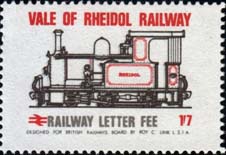
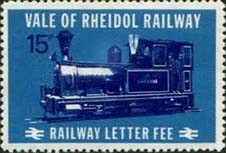
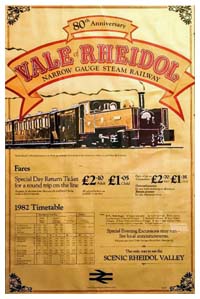
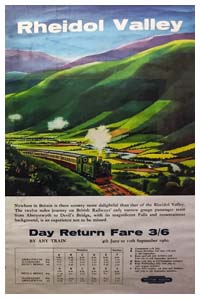
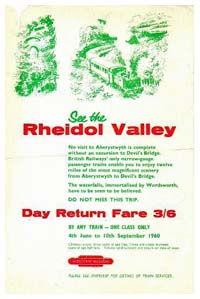
22 Jul 2013 - Part of London Bridge Station to be Rebuilt in mid-Wales
5 Sep 2014 - Historic Steam Engine to Arrive in Aberystwyth for First Time in 92 Years
8 Jul 2017 - Vale of Rheidol's Wheels for Aberystwyth Cliff Railway
19 Jul 2017 - New Arrival at the Vale of Rheidol Railway
5 Apr 2018 - Things that are Already Named After the Prince of Wales
Vale of Rheidol Railway
Vale of Rheidol Light Railway Order
Cwmystwyth Mines
Mining History Network (Link fails 3 May 2022)
Arriva Trains Wales
National Rail Enquiries (Link fails 1 May 2023)
 Vale of Rheidol Light RailwayW.J.K. Davies.1964Ian Allan.Paperback56 pages, 12 x 17.6 cm, used £1.50This booklet is not intended as a complete history of the railway but as the established histories are out of print, this booklet includes basic historical data in the hope it may be of use to enthusiasts for reference purposes.
Vale of Rheidol Light RailwayW.J.K. Davies.1964Ian Allan.Paperback56 pages, 12 x 17.6 cm, used £1.50This booklet is not intended as a complete history of the railway but as the established histories are out of print, this booklet includes basic historical data in the hope it may be of use to enthusiasts for reference purposes. The Vale of Rheidol RailwayHugh Ballantyne.2001Past & Present Publishing Ltd.Hardcover80 pages, 17.2 x 23.8 cm, Used £5.31Takes a journey on the narrow gauge line that winds for 12 miles up the valley of the River Rheidol to its terminus nearly 700 feet above sea level at Devil's Bridge. This book looks at the early history of the railway in the Aberystwyth area, as well as the line's locomotives, coaches, and wagons.
The Vale of Rheidol RailwayHugh Ballantyne.2001Past & Present Publishing Ltd.Hardcover80 pages, 17.2 x 23.8 cm, Used £5.31Takes a journey on the narrow gauge line that winds for 12 miles up the valley of the River Rheidol to its terminus nearly 700 feet above sea level at Devil's Bridge. This book looks at the early history of the railway in the Aberystwyth area, as well as the line's locomotives, coaches, and wagons. The Vale of Rheidol Railway: Rheilffordd Cwm RheidolAllan C. Baker.2003Phyllis Rampton Narrow Gauge Railway Trust.Paperback32 pages, 20.4 x 29 cm, used US$1.00A Visitors Guide containing a brief history of the railway, recent achievements, details of locomotives and rolling stock, together with what can be seen on a journey along the beautiful valley of the Afon Rheidol (River Rheidol). First edition.
The Vale of Rheidol Railway: Rheilffordd Cwm RheidolAllan C. Baker.2003Phyllis Rampton Narrow Gauge Railway Trust.Paperback32 pages, 20.4 x 29 cm, used US$1.00A Visitors Guide containing a brief history of the railway, recent achievements, details of locomotives and rolling stock, together with what can be seen on a journey along the beautiful valley of the Afon Rheidol (River Rheidol). First edition. The Vale of Rheidol Railway: Rheilfford CWM RheidolAllan C. Baker.2008Phyllis Rampton Narrow Gauge Railway Trust.Paperback28 pages, 20.4 x 28.6 cm, used £0.30A Visitors Guide containing a brief history of the railway, recent achievements, details of locomotives and rolling stock, together with what can be seen on a journey along the beautiful valley of the Afon Rheidol (River Rheidol).
The Vale of Rheidol Railway: Rheilfford CWM RheidolAllan C. Baker.2008Phyllis Rampton Narrow Gauge Railway Trust.Paperback28 pages, 20.4 x 28.6 cm, used £0.30A Visitors Guide containing a brief history of the railway, recent achievements, details of locomotives and rolling stock, together with what can be seen on a journey along the beautiful valley of the Afon Rheidol (River Rheidol).


